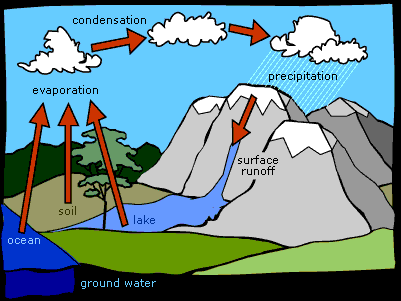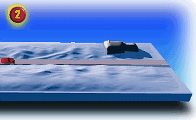|
|
 Clouds Clouds
What are clouds?
 A cloud is a large collection of very tiny droplets of water or ice crystals. The droplets are so small and light that they can float in the air. A cloud is a large collection of very tiny droplets of water or ice crystals. The droplets are so small and light that they can float in the air.
How are clouds formed?
 All air contains water, but near the ground it is usually in the form of an invisible gas called water
vapor. When warm air rises, it expands and cools. Cool air can't hold as much water vapor as warm air, so some of the vapor condenses onto tiny pieces of
dust that are floating in the air and forms a tiny droplet around each dust particle. When billions of these droplets come together they become a visible
cloud. All air contains water, but near the ground it is usually in the form of an invisible gas called water
vapor. When warm air rises, it expands and cools. Cool air can't hold as much water vapor as warm air, so some of the vapor condenses onto tiny pieces of
dust that are floating in the air and forms a tiny droplet around each dust particle. When billions of these droplets come together they become a visible
cloud.
Why are clouds white?

 Clouds are white because they reflect the light of the sun. Light is made up of colors of the rainbow and when you add them all
together you get white. The sun appears a yellow color because it sends out more yellow light than any other color. Clouds reflect all the colors the exact
same amount so they look white. Clouds are white because they reflect the light of the sun. Light is made up of colors of the rainbow and when you add them all
together you get white. The sun appears a yellow color because it sends out more yellow light than any other color. Clouds reflect all the colors the exact
same amount so they look white.
Why do clouds turn gray?
 Clouds are made up of tiny water droplets or ice crystals, usually a mixture of both. The water
and ice scatter all light, making clouds appear white. If the clouds get thick enough or high enough all the light above does not make it through, hence the
gray or dark look. Also, if there are lots of other clouds around, their shadow can add to the gray or multicolored gray appearance. Clouds are made up of tiny water droplets or ice crystals, usually a mixture of both. The water
and ice scatter all light, making clouds appear white. If the clouds get thick enough or high enough all the light above does not make it through, hence the
gray or dark look. Also, if there are lots of other clouds around, their shadow can add to the gray or multicolored gray appearance.
Why do clouds float?
 A cloud is made up of liquid water droplets. A cloud forms when air is heated by
the sun. As it rises, it slowly cools it reaches the saturation point and water condenses, forming a cloud. As long as the cloud and the air that its made of
is warmer than the outside air around it, it floats! A cloud is made up of liquid water droplets. A cloud forms when air is heated by
the sun. As it rises, it slowly cools it reaches the saturation point and water condenses, forming a cloud. As long as the cloud and the air that its made of
is warmer than the outside air around it, it floats!
How do clouds move?
 Clouds move with the wind. High cirrus clouds are pushed along by the jet stream, sometimes
traveling at more than 100 miles-per-hour. When clouds are part of a thunderstorm they usually travel at 30 to 40 mph. Clouds move with the wind. High cirrus clouds are pushed along by the jet stream, sometimes
traveling at more than 100 miles-per-hour. When clouds are part of a thunderstorm they usually travel at 30 to 40 mph.
How is fog formed?
There are many different types of fog, but fog is mostly formed when southerly winds bring warm, moist air
into a region, possibly ending a cold outbreak. As the warm, moist air flows over much colder soil or snow, dense fog often forms. Warm, moist air is cooled
from below as it flows over a colder surface. If the air is near saturation, moisture will condense out of the cooled air and form fog. With light winds,
the fog near the ground can become thick and reduce visibilities to zero.
 |
 |
 You need warm air! Southerly winds bring warm, moist air
over cold ground or snow. You need warm air! Southerly winds bring warm, moist air
over cold ground or snow. |
 Fog Forms! Moisture condenses into fog as air is cooled
from below. Fog Forms! Moisture condenses into fog as air is cooled
from below. |
Why do clouds form at different heights in the atmosphere?
The characteristics of clouds are dictated by the elements available, including the amount of water vapor, the temperatures at
that height, the wind, and the interplay of other air masses.
|
|